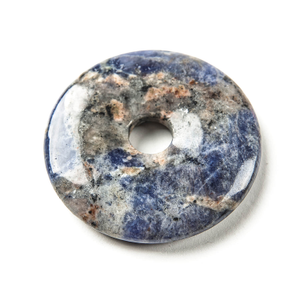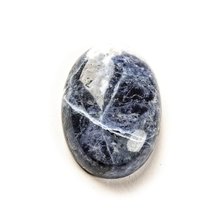- Jewelry-Making Supplies ▾
Design Jewelry with Confidence!
Seed Beads
Thread, Wire, & Stringing Materials
Findings & Components
Everything Else
- Kits & Collections ▾
Assemble Your World
Kits & Collections
- Subscriptions ▾
Want monthly Beading Happiness?
Subscriptions
- Learn to Make ▾
Want to learn more?
- Discounts & Deals ▾
Explore Today's Promotions!
-
Seed Beads
Thread, Wire, & Stringing Materials
Findings & Components
Everything Else
-
Kits & Collections
-
Subscriptions
- Home
- Beads
- Gemstone Beads
- Sodalite
ONLY VISIBLE ON EDIT MODE *
subtitle
page_content
videos
how to videos
Sodalite

Sodalite
History of Sodalite
Discovered in Greenland in the early 19th century, Sodalite gained significant popularity during the late 19th century when vast deposits were found in Ontario, Canada. It has been used in decorative arts, jewelry, and as a stone of insight and mental enhancement. Its name is derived from its sodium content, highlighting its chemical composition. Significant sources of Sodalite include Brazil, Canada, Namibia, and Russia, making it a stone with a global presence.
Color and Jewelry-Design with Sodalite Beads
The deep blue of Sodalite, reminiscent of the night sky, offers endless inspiration for jewelry design:
- Pairing Sodalite beads with silver findings can highlight their vibrant color and enhance their natural elegance.
- Combining Sodalite with other gemstones that promote mental clarity and emotional balance, such as Amethyst or Lapis Lazuli, can create synergistic effects in jewelry.
- Using Sodalite beads in pieces designed to be worn near the throat chakra can maximize their impact on communication and self-expression.
Sodalite beads are perfect for crafting necklaces, bracelets, earrings, and rings that not only draw the eye but also promote a deeper understanding and connection to one’s inner truth.
Physical Properties
Sodalite is a tectosilicate mineral that belongs to the Sodalite group, known for its rich, royal blue color. Its properties include:
- Hardness: Sodalite has a Mohs hardness of about 5.5 to 6, making it relatively durable for jewelry use.
- Luster: Exhibits a vitreous to greasy luster, contributing to its appealing shine.
- Transparency: Sodalite is generally opaque, which allows for the vivid display of its characteristic blue color and white streaks.
Metaphysical Properties
Sodalite is celebrated for its metaphysical properties, believed to:
- Enhance intellectual abilities, logic, and analytical reasoning.
- Promote emotional balance, calming panic attacks, and bringing tranquility.
- Facilitate truthful communication and expression, both with oneself and others.
Healing Properties
In addition to its emotional and intellectual benefits, Sodalite is also thought to offer physical healing properties:
- Supporting the regulation of blood pressure and improving hydration.
- Boosting the immune system and combating radiation damage by soaking up electromagnetic smog.
- Helping in the treatment of throat, vocal cords, and larynx issues.
Sodalite beads offer jewelry designers the opportunity to create pieces that are not just visually stunning but also imbued with profound intellectual and emotional benefits. The stone’s deep blue color and calming energy make it a favorite among those seeking to enhance their mental clarity, communication skills, and emotional well-being. Let the serene beauty and thoughtful energy of Sodalite inspire your next jewelry project, crafting pieces that resonate with the essence of wisdom and truth.
History of Sodalite
Discovered in Greenland in the early 19th century, Sodalite gained significant popularity during the late 19th century when vast deposits were found in Ontario, Canada. It has been used in decorative arts, jewelry, and as a stone of insight and mental enhancement. Its name is derived from its sodium content, highlighting its chemical composition. Significant sources of Sodalite include Brazil, Canada, Namibia, and Russia, making it a stone with a global presence.
Color and Jewelry-Design with Sodalite Beads
The deep blue of Sodalite, reminiscent of the night sky, offers endless inspiration for jewelry design:
- Pairing Sodalite beads with silver findings can highlight their vibrant color and enhance their natural elegance.
- Combining Sodalite with other gemstones that promote mental clarity and emotional balance, such as Amethyst or Lapis Lazuli, can create synergistic effects in jewelry.
- Using Sodalite beads in pieces designed to be worn near the throat chakra can maximize their impact on communication and self-expression.
Sodalite beads are perfect for crafting necklaces, bracelets, earrings, and rings that not only draw the eye but also promote a deeper understanding and connection to one’s inner truth.
Physical Properties
Sodalite is a tectosilicate mineral that belongs to the Sodalite group, known for its rich, royal blue color. Its properties include:
- Hardness: Sodalite has a Mohs hardness of about 5.5 to 6, making it relatively durable for jewelry use.
- Luster: Exhibits a vitreous to greasy luster, contributing to its appealing shine.
- Transparency: Sodalite is generally opaque, which allows for the vivid display of its characteristic blue color and white streaks.
Metaphysical Properties
Sodalite is celebrated for its metaphysical properties, believed to:
- Enhance intellectual abilities, logic, and analytical reasoning.
- Promote emotional balance, calming panic attacks, and bringing tranquility.
- Facilitate truthful communication and expression, both with oneself and others.
Healing Properties
In addition to its emotional and intellectual benefits, Sodalite is also thought to offer physical healing properties:
- Supporting the regulation of blood pressure and improving hydration.
- Boosting the immune system and combating radiation damage by soaking up electromagnetic smog.
- Helping in the treatment of throat, vocal cords, and larynx issues.
Sodalite beads offer jewelry designers the opportunity to create pieces that are not just visually stunning but also imbued with profound intellectual and emotional benefits. The stone’s deep blue color and calming energy make it a favorite among those seeking to enhance their mental clarity, communication skills, and emotional well-being. Let the serene beauty and thoughtful energy of Sodalite inspire your next jewelry project, crafting pieces that resonate with the essence of wisdom and truth.
-
Sort By
Relevance:Show:FAQ: Navigating the World of Seed Beads- What are the different types of seed beads?
Seed beads come in various types, including Czech seed beads, Japanese seed beads, and Chinese seed beads. Each type offers its own unique characteristics in terms of size, shape, and finish.
- What is the difference between seed beads and Czech beads?
While both seed beads and Czech beads are used in jewelry making, Czech beads are known for their exceptional quality and craftsmanship. They often feature intricate designs and vibrant colors, making them a favorite among artisans.
- What can you do with seed beads?
The possibilities with seed beads are endless! From intricate beadweaving patterns to simple stringing techniques, you can create a wide range of jewelry pieces, accessories, and embellishments for clothing and home decor.
- What is the difference between seed beads and delica beads?
Seed beads and delica beads are both used in beadweaving, but they differ in shape and size. Seed beads have a rounded shape, while delica beads are cylindrical. Delica beads are also known for their uniform size and shape, making them ideal for precise beadwork.
-
-
Highest Quality
Products
100% Money
Back Guarantee
Fast
Shipping
Best Teaching &
Customer Service
You'll want these emails...
Get Free Projects & Inspiration
Get Free Projects & Inspiration
- Bullet 1
- Bullet 2
- Bullet 3
-Transparent.png)
240 N Prospect St. Hagerstown, MD 21740
(301) 393-4667
hello@potomacbeads.com
Copyright © PotomacBeads










